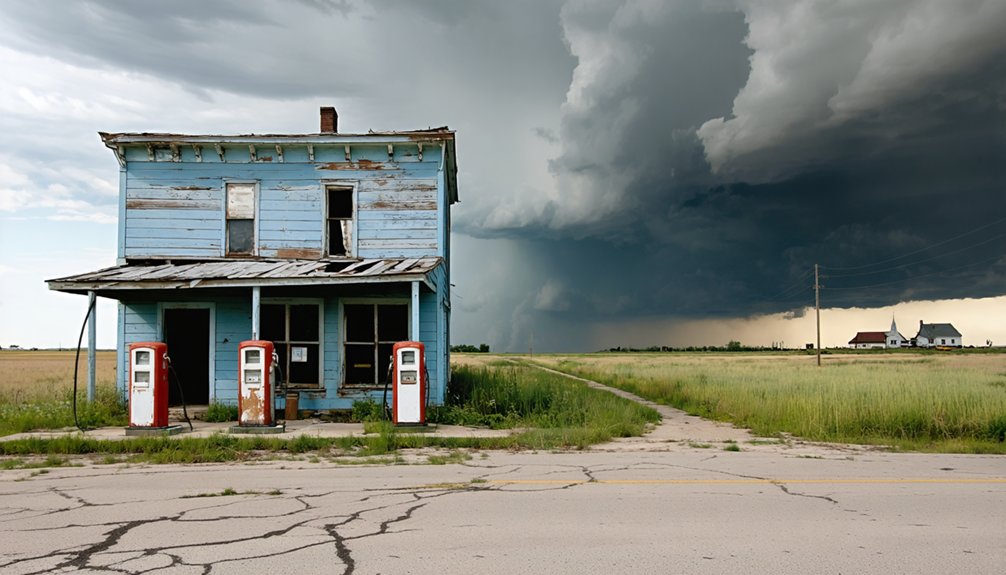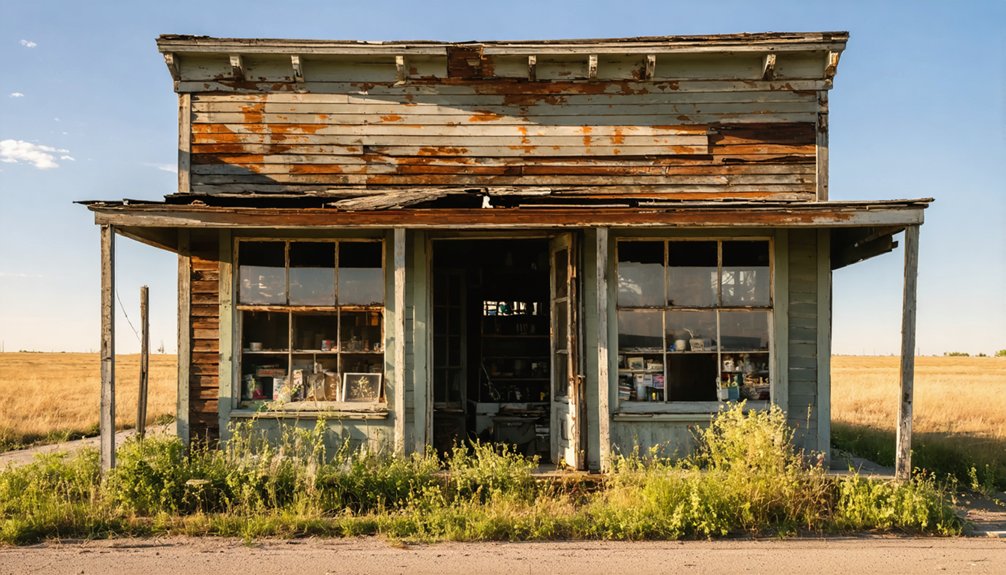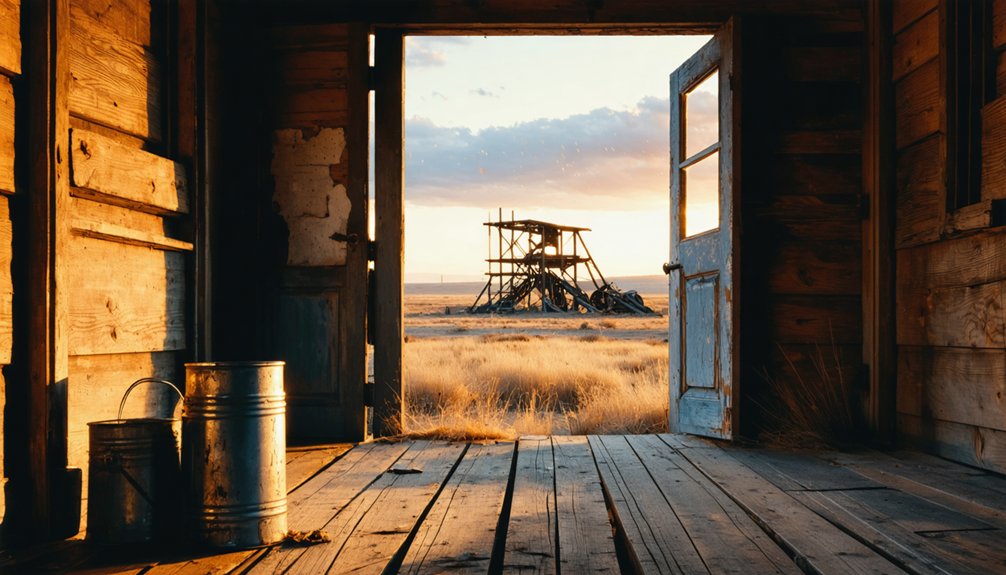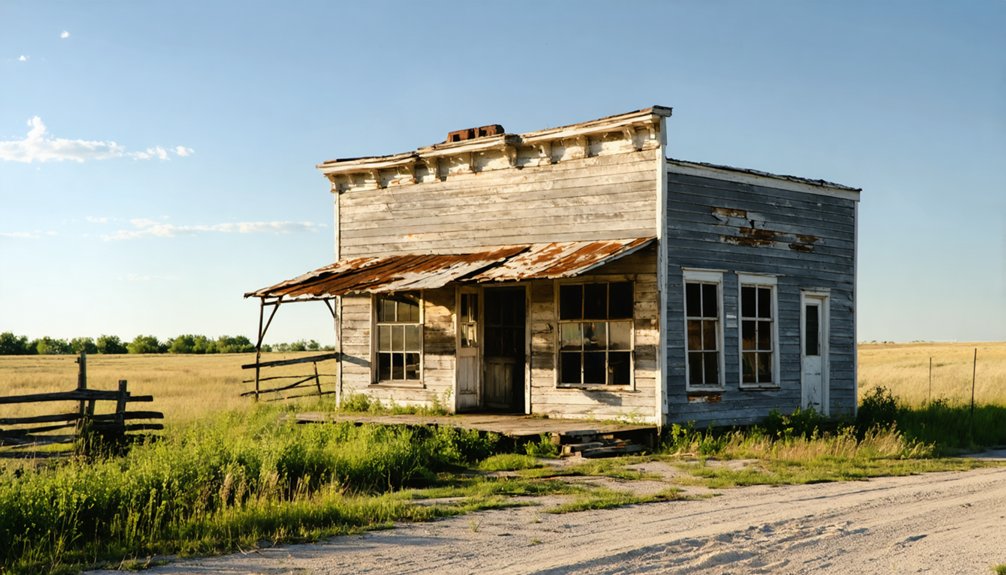You’ll find Lancaster City’s remains in Lawrence County, South Dakota, where ambitious prospectors established this Black Hills mining settlement in 1877 during the gold rush era. Life centered around mineral extraction, with families dwelling in wooden shacks while seeking their fortunes. Though the town thrived initially, declining ore deposits led to its abandonment by the early 1900s. Today, weathered structures and an old pioneer cemetery tell a compelling story of boom-and-bust frontier ambition.
Key Takeaways
- Founded in 1877 during the Black Hills Gold Rush by Nimrod Lancaster, the town emerged as a prosperous mining community.
- The town flourished initially due to gold discoveries but declined when mining operations became costly and ore deposits depleted.
- Post office closure in 1917 marked a significant milestone in Lancaster City’s transformation into a ghost town.
- Physical remnants include a combination church-jail building, pioneer cemetery, and old schoolhouse maintained by local farming families.
- The abandoned town’s structures and marked hiking trails serve as historical remnants of South Dakota’s gold rush era.
The Origins of Lancaster City
While the Black Hills Gold Rush drew countless prospectors to South Dakota in the late 1800s, it was Nimrod Lancaster who established his namesake mining community in 1877. The founder’s impact on the region became evident as he strategically laid out the town amid the rugged terrain of Lawrence County, positioning it to take advantage of the area’s rich mineral deposits.
You’ll find Lancaster City’s origins deeply rooted in the mining significance of the Black Hills, where dense forests and challenging landscapes shaped the settlement’s development. Just as Dakota City residents relocated when their town was bypassed, many settlers moved to find better opportunities in the region. Similar to how founded in spring 1911 marked the beginning of another Lancaster community across the Atlantic, this mining town represented a fresh start for its settlers.
Like many frontier towns of its era, Lancaster City emerged as part of a broader pattern of mining communities springing up throughout the region. The town’s establishment reflected the entrepreneurial spirit that characterized the American West during the explosive growth of the 1870s.
Mining Boom and Early Settlement
The discovery of gold in the Black Hills sparked an unprecedented rush of fortune seekers to the region in 1874, transforming Lancaster City’s landscape from wilderness to bustling frontier settlement. The Gordon Party stockade marked one of the first illegal settlements in the area, setting a precedent for future development.
Gold’s discovery ignited an explosive migration to Lancaster City in 1874, turning untamed wilderness into a thriving frontier boomtown.
Mining technology evolved rapidly as prospectors adapted to the challenging terrain near Deadwood Gulch and Whitewood Creek, where cultural influences from experienced miners shaped early development. Early prospectors relied heavily on picks and shovels as they searched for gold deposits in creek beds.
You’ll find the progression of Lancaster City’s mining boom reflected in these key developments:
- Initial placer mining claims staked by pioneering prospectors like the Gay brothers
- Introduction of stamp mills, including the Jones and Pinney operation in late 1876
- Development of essential infrastructure with the Black Hills & Fort Pierre Railroad
The area’s remoteness demanded innovation in supply logistics, while competition for resources between major operators like George Hearst’s Homestake Mine shaped the economic landscape of these frontier settlements.
Daily Life in a Black Hills Mining Town
You’d find life in Lancaster City’s mining camps bustling with activity, from the cramped wooden shacks and canvas tents where miners rested between shifts to the basic cooking areas where they prepared simple meals of beans, bread, and salted meat.
After long days of backbreaking work, you could join other miners at the camp’s social gathering spots, where card games, storytelling, and occasional musical entertainment provided much-needed relief from the daily grind. The local Gem Variety Theater became a popular destination for miners seeking entertainment after their shifts. Much like in Deadwood, gunfights erupted frequently over mining claims and territory disputes.
Women in the camp, though fewer in number during the early days, played essential roles by running boarding houses, washing clothes, preparing meals, and eventually establishing more permanent household structures as the settlement grew.
Mining Camp Living Conditions
Life in Lancaster City’s mining camps challenged even the hardiest souls, as families squeezed into cramped wooden shacks that had evolved from earlier canvas tent settlements. Your living quarters would’ve been hastily constructed from local timber, offering minimal protection from the harsh Black Hills weather.
Privacy was scarce as tools, supplies, and multiple generations shared the tight spaces. Coal dust and smoke from stoves and heating filled the air, making it nearly impossible to keep surfaces clean.
Daily survival in these conditions required:
- Managing without basic utilities like running water or proper sanitation
- Preparing meals in makeshift cooking areas, often sharing resources with neighbors
- Maintaining cleanliness despite overcrowding and limited facilities
You’d find yourself constantly adapting to the harsh realities of mining camp life, where every day tested your resilience against the elements and primitive conditions that defined these rugged frontier settlements.
Social Activities After Work
After grueling shifts in the mines, Lancaster City’s workers found vibrant social life awaiting them across the bustling town’s establishments.
You’d find miners gathering at the local saloon, where card games, live music, and tales of the day’s work filled the evening air. The Treasure Coaches were a frequent topic of discussion, especially after hold-ups made the news. Like many other Black Hills towns, Lancaster City eventually succumbed to changing economic forces. The town’s dance hall buzzed with energy during social gatherings, while the theater showcased traveling performers and local talent.
Community events brought everyone together, from holiday celebrations to impromptu sports competitions. You could join a fraternal lodge for fellowship, attend church services, or spend quiet evenings at reading clubs.
When you needed outdoor recreation, the Black Hills offered plenty of hunting, fishing, and exploring opportunities. The general store served as a daily meeting spot where you’d catch up on news and share stories with fellow townspeople.
Women’s Roles and Duties
While men toiled deep in the mines, women in Lancaster City shouldered the demanding responsibilities of frontier life. Their domestic labor ranged from hauling ice-cold water for laundry to preparing meals in challenging conditions.
You’d find them managing households with limited supplies, often waiting weeks for mule trains to deliver basic necessities. The harsh weather conditions meant that many homes were poorly insulated structures where snow would accumulate inside.
These resilient women created paths to economic independence through:
- Operating profitable boarding houses that served miners
- Providing essential laundry services, despite minimal compensation
- Running successful restaurants and hotels with profits from their ventures
Children pitched in by gathering wild berries while mothers preserved family stability in harsh conditions.
Black women like Lucretia Marchbanks overcame both racial and gender barriers, contributing considerably to the community’s economic fabric while maintaining domestic duties in this rugged mining town.
Economic Challenges and Population Shifts

You’ll find Lancaster City’s trajectory mirrors that of many Black Hills mining towns, where initial prosperity in 1877 drew hundreds of hopeful settlers seeking their fortunes in mineral extraction.
As ore deposits declined and mining operations ceased, you could witness the town’s gradual emptying, with businesses shuttering and families relocating to more promising locations.
The closure of Lancaster City’s post office in 1917 marked a significant milestone in the town’s decline, reflecting a pattern seen throughout the region where mining communities transformed into ghost towns once their economic foundations crumbled.
Mining Boom and Bust
During Lancaster City’s early days, the discovery of gold near French Creek in the 1870s ignited a mining fever that would transform this corner of South Dakota.
You’d have witnessed the rapid evolution of mining techniques, from simple placer operations to sophisticated hard rock extraction by 1880 as surface deposits depleted.
The community dynamics shifted dramatically when George Hearst purchased the Homestake Mine in 1877, bringing unprecedented investment and infrastructure.
The boom-and-bust cycle would define Lancaster City’s fate through three distinct phases:
- Initial gold rush prosperity with placer mining (1870s)
- Shift to costly hard rock mining operations (1880s)
- Economic decline as mines closed in the early 1900s
Population Migration Patterns
The decline of Lancaster City’s mining operations sparked a dramatic exodus that would reshape the town’s demographic fabric forever.
You’ll find that the town’s story mirrors countless other rural South Dakota communities, where families increasingly abandoned their roots in search of urban opportunities. As agricultural mechanization reduced available jobs and mining activity dwindled, younger residents led the charge toward larger cities, leaving behind an aging population struggling to maintain basic services.
The ripple effects were profound – you could see it in the shuttered schools, closed medical facilities, and deteriorating infrastructure.
Without a strong tax base or economic diversity beyond farming and mining, Lancaster City couldn’t sustain itself. The exodus created a self-reinforcing cycle: as services declined, more residents left, further weakening the town’s ability to support its remaining inhabitants.
Local Business Closures
One after another, local businesses along Main Street succumbed to Lancaster City’s economic downturn throughout the 1960s.
While specific details about Lancaster City’s business closures remain elusive in historical records, the broader pattern of economic challenges faced by small towns across South Dakota during this period suggests significant business impact on the local community.
- Historical records from this period are limited, making it difficult to pinpoint exact closure dates and business names.
- The community’s response to these economic shifts hasn’t been thoroughly documented.
- The overall pattern mirrors similar small town experiences throughout South Dakota during this era.
The story of Lancaster City’s business district reflects a common theme in American history – the delicate balance between community resilience and economic forces that reshape small towns across the heartland.
The Path to Abandonment

As mining opportunities dwindled in Lancaster City during the late 19th century, this once-bustling South Dakota mining town began its slow descent into abandonment.
The key abandonment factors emerged as mineral resources depleted and the mining industry couldn’t sustain the local economy. You would’ve witnessed families gradually departing as essential services disappeared, leaving behind empty storefronts and silent streets.
The ghost town dynamics followed a familiar pattern: the lack of economic diversification, combined with insufficient government support and poor transportation infrastructure, accelerated the town’s decline.
The community’s social fabric unraveled as schools closed and businesses shuttered. Without the promise of prosperity that had originally drawn settlers to Nimrod Lancaster’s namesake town, the remaining residents had little choice but to seek opportunities elsewhere.
Physical Remnants Today
Standing amid the windswept prairie, Lancaster City’s remaining physical structures tell a poignant story of pioneer ambition and eventual decline.
Today, you’ll find a landscape marked by physical deterioration, where nature steadily reclaims what humans once built. The few surviving buildings showcase weathered walls and bowing roofs, while foundations peek through grassland as subtle reminders of frontier dreams.
Historical preservation efforts have focused on three key sites:
- The combination church-jail building, still standing but requiring urgent stabilization
- A pioneer cemetery with weather-worn headstones documenting early settlers
- The old schoolhouse, maintained sporadically by local farming families
You can explore these remnants via marked hiking trails, though you’re advised to admire structures from a safe distance due to their fragile condition.
Legacy in South Dakota’s Mining History

While the Black Hills gold rush of 1874 transformed South Dakota’s mining landscape, Lancaster City emerged three years later as a reflection of the state’s burgeoning mineral wealth.
You’ll find Lancaster’s story intertwined with the broader evolution of mining innovations across the region, from basic prospecting to advanced cyanide leaching techniques that revolutionized gold extraction.
Like many boomtowns of its era, Lancaster City’s legacy extends beyond its short-lived prosperity.
The echoes of Lancaster City’s fleeting golden age resonate through time, leaving an indelible mark on South Dakota’s cultural fabric.
It’s part of a larger narrative that shaped South Dakota’s development, spurring the creation of essential infrastructure and diverse communities.
As mining operations expanded and contracted, they brought both economic opportunities and challenges.
Today, the site stands as a symbol of an industry that’s since adapted to modern environmental regulations and reclamation requirements, marking the shift from unfettered expansion to managed resource extraction.
Frequently Asked Questions
What Native American Tribes Originally Inhabited the Lancaster City Area?
After a million years of searching records, you’ll find no definitive proof of which tribes inhabited Lancaster City specifically, though broader Sioux history and tribal culture dominated South Dakota’s pre-settlement landscape.
Were There Any Notable Crimes or Lawlessness During Lancaster City’s Peak?
You won’t find reliable crime statistics or documented law enforcement cases from Lancaster City’s peak – historical records are too sparse to confirm any specific instances of criminal activity or lawlessness.
Did Any Famous Historical Figures Ever Visit Lancaster City?
Like a dusty page waiting to be filled, you won’t find any famous visitors in the records. Historical significance centered purely on mining operations, without any documented visits from prominent historical figures.
What Specific Minerals or Metals Were Primarily Mined in Lancaster?
You’d find that gold mining dominated Lancaster’s operations, with some silver extraction occurring alongside it, though detailed records of specific production amounts haven’t survived from those pioneering days.
Are There Any Documented Paranormal Activities or Ghost Stories From Lancaster City?
Among thousands of documented ghost town stories in South Dakota, you won’t find any confirmed paranormal encounters or ghost sightings from Lancaster City. Historical records show it’s one of few mining towns without supernatural tales.
References
- https://blackhillsvisitor.com/learn/owanka/
- https://en.wikipedia.org/wiki/Lancaster_City
- https://www.sdpb.org/rural-life-and-history/2023-08-21/some-black-hills-ghost-towns-and-their-origins
- https://www.sdhspress.com/journal/south-dakota-history-2-2/some-black-hills-ghost-towns-and-their-origins/vol-02-no-2-some-black-hills-ghost-towns-and-their-origins.pdf
- https://973kkrc.com/creepiest-haunted-place-in-south-dakota-minnesota-and-iowa/
- https://www.youtube.com/watch?v=_0WNYsFLSLA
- https://theclio.com/entry/181864
- https://en.wikipedia.org/wiki/List_of_ghost_towns_in_South_Dakota
- https://www.blackhillsbadlands.com/blog/post/old-west-legends-mines-ghost-towns-route-reimagined/
- https://www.geotab.com/ghost-towns/



